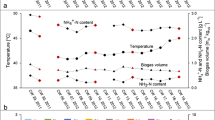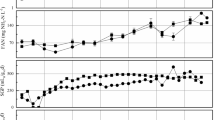Abstract
The impacts of feeding ratio and loading rate on the microbial community during co-digestion of grass silage with cow manure in an anaerobic laboratory continuously stirred tank reactor were investigated by 16S rRNA gene-based fingerprints. The microbial community remained stable when the reactor was fed with cow manure alone and with up to 20% of grass silage in feedstock at an organic loading rate (OLR) of 2 kg VS m−3 day−1. Large changes in the bacterial community were observed when the loading ratio of grass was increased to 40%, while there was little change in the archaeal community. During the increase in OLR from 2 to 4 kg VS m−3 day−1 the bacterial community structure showed few differences, whereas Archaea was undetectable. Sequencing of the major DGGE bands indicated that the phylum Bacteriodetes predominated in the bacterial community. Two unclassified bacteria with high abundance survived throughout the operation of the reactor.





Similar content being viewed by others
References
Amon B, Kryvoruchko V, Amon T, Zechmeister-Boltenstern S (2006) Methane, nitrous oxide and ammonia emissions during storage and after application of dairy cattle slurry and influence of slurry treatment. Agr Ecosyst Environ 112:153–162
Angelidaki I, Ahring BK (1993) Thermophilic anaerobic digestion of livestock waste: the effect of ammonia. Appl Microbiol Biotechnol 38:560–564
Bodelier PL, Meima-Franke M, Zwart G, Laanbroek HJ (2005) New DGGE strategies for the analyses of methanotrophic microbial communities using different combinations of existing 16S rRNA-based primers. FEMS Microbiol Ecol 52:163–174
Burrell PC, O’Sullivan C, Song H, Clarke WP, Blackall LL (2004) Identification, detection, and spatial resolution of Clostridium populations responsible for cellulose degradation in a methanogenic landfill leachate bioreactor. Appl Environ Microbiol 70:2414–2419
Chachkhiani M, Dabert P, Abzianidze T, Partskhaladze G, Tsiklauri L, Dudauri T, Godon JJ (2004) 16S rDNA characterisation of bacterial and archaeal communities during start-up of anaerobic thermophilic digestion of cattle manure. Bioresour Technol 93:227–232
Chynoweth DP, Pullammanappallil P (1996) Anaerobic digestion of municipal solid wastes. In: Palmisano AC, Barlaz MA (eds) Microbiology of solid waste. CRC Press, Boca Raton, pp 71–113
Clemens J, Trimborn M, Weiland P, Amon B (2006) Mitigation of greenhouse gas emissions by anaerobic digestion of cattle slurry. Agr Ecosyst Environ 112:171–177
Cole JR, Chai B, Farris RJ, Wang Q, Kulam-Syed-Mohideen AS, McGarrell DM, Bandela AM, Cardenas E, Garrity GM, Tiedje JM (2007) The ribosomal database project (RDP-II): introducing myRDP space and quality controlled public data. Nucleic Acids Res 35:169–172
Connaughton S, Collins G, O’Flaherty V (2006) Development of microbial community structure and activity in a high-rate anaerobic bioreactor at 18 degrees C. Water Res 40:1009–1017
Dearman B, Marschner P, Bentham RH (2006) Methane production and microbial community structure in single-stage batch and sequential batch systems anaerobically co-digesting food waste and biosolids. Appl Microbiol Biotechnol 69:589–596
Dunbar J, Ticknor LO, Kuske CR (2001) Phylogenetic specificity and reproducibility and new method for analysis of terminal restriction fragment profiles of 16S rRNA genes from bacterial communities. Appl Environ Microbiol 67:190–197
Felsenstein J (1985) Confidence limits on phylogenies: an approach using the bootstrap. Evolution 39:783–791
Fernandez A, Huang S, Seston S, Xing J, Hickey R, Criddle C, Tiedje J (1999) How stable is stable? Function versus community composition. Appl Environ Microbiol 65:3697–3704
Fernandez AS, Hashsham SA, Dollhopf SL, Raskin L, Glagoleva O, Dazzo FB, Hickey RF, Criddle CS, Tiedje JM (2000) Flexible community structure correlates with stable community function in methanogenic bioreactor communities perturbed by glucose. Appl Environ Microbiol 66:4058–4067
Fischer JR, Iannotti EL, Fulhage CD (1983) Production of methane gas from combinations of wheat straw and swine manure. Transactions ASAE 26:546–548
Fujita M, Scharer JM, Moo-Young M (1980) Effect of corn stover addition on the anaerobic digestion of swine manure. Agric Wastes 2:177–184
Hashimoto AG (1983) Conversion of straw-manure mixtures to methane at mesophilic and thermophilic temperatures. Biotechnol Bioeng 25:185–200
Hernon F, Forbes C, Colleran E (2006) Identification of mesophilic and thermophilic fermentative species in anaerobic granular sludge. Water Sci Technol 54:19–24
Hills DJ (1980) Biogas from high solids combinations of dairy manure and barley straw. Transactions ASAE 23:1500–1504
Hugenholtz P, Goebel BM, Pace NR (1998) Impact of culture-independent studies on the emerging phylogenetic view of bacterial diversity. J Bacteriol 180:4765–4774
Jackon DA, Somers KM, Harvey HH (1989) Similarity coefficients: measure of co-occurrence and association of simple measures of occurrence. Am Nat 133:436–453
Kaparaju P, Luostarinen S, Kalmari E, Kalmari J, Rintala J (2002) Co-digestion of energy crops and industrial confectionery by-products with cow manure: batch scale and farm-scale evaluation. Water Sci Technol 45:275–280
Kitts CL (2001) Terminal restriction fragment patterns: a tool for comparing microbial communities and assessing community dynamics. Curr Issues Intest Microbiol 2:17–25
Koizumi Y, Kojima H, Fukui M (2003) Characterization of depth-related microbial community structure in lake sediment by denaturing gradient gel electrophoresis of amplified 16S rDNA and reversely transcribed 16S rRNA fragments. FEMS Microbiol Ecol 46:147–157
Lehtomäki A, Huttunen S, Rintala J (2007) Laboratory investigations on co-digestion of energy crops, crop residues and cow manure: effect of crop to manure ratio. Resour Conserv Recycl 51:591–609
Leser TD, Amenuvor JZ, Jensen TK, Lindecrona RH, Boye M, Moller K (2002) Culture-independent analysis of gut bacteria: the pig gastrointestinal tract microbiota revisited. Appl Environ Microbiol 68:673–690
Lueders T, Friedrich MW (2003) Evaluation of PCR amplification bias by terminal restriction fragment length polymorphism analysis of small-subunit rRNA and mcrA genes by using defined template mixtures of methanogenic pure cultures and soil DNA extracts. Appl Environ Microbiol 69:320–326
Lynd LR, Weimer PJ, van Zyl WH, Pretorius IS (2002) Microbial cellulose utilization: fundamentals and biotechnology. Microbiol Mol Biol Rev 66:506–577
McMahon KD, Stroot PG, Mackie RI, Raskin L (2001) Anaerobic codigestion of municipal solid waste and biosolids under various mixing conditions-II: microbial population dynamics. Water Res 35:1817–1827
Mladenovska Z, Hartmann H, Kvist T, Sales-Cruz M, Gani R, Ahring BK (2006) Thermal pretreatment of the solid fraction of manure: impact on the biogas reactor performance and microbial community. Water Sci Technol 53:59–67
Moeseneder MM, Arrieta JM, Muyzer G, Winter C, Herndl GJ (1999) Optimization of terminal-restriction fragment length polymorphism analysis for complex marine bacterioplankton communities and comparison with denaturing gradient gel electrophoresis. Appl Environ Microbiol 65:3518–3525
Muyzer G (1999) DGGE/TGGE a method for identifying genes from natural ecosystems. Curr Opin Microbiol 2:317–322
Nakajima H, Hongoh Y, Noda S, Yoshida Y, Usami R, Kudo T, Ohkuma M (2006) Phylogenetic and morphological diversity of Bacteroidales members associated with the gut wall of termites. Biosci Biotechnol Biochem 70:211–218
Noike T, Endo G, Chang J, Yaguchi J, Matsumoto J (1985) Characteristics of carbohydrate degradation and the rate-limiting step in anaerobic digestion. Biotechnol Bioeng 27:1482–1489
O’Sullivan CA, Burrell PC, Clarke WP, Blackall LL (2005) Structure of a cellulose degrading bacterial community during anaerobic digestion. Biotechnol Bioeng 92:871–878
Saikaly PE, Oerther DB (2004) Bacterial competition in activated sludge: theoretical analysis of varying solids retention times on diversity. Microb Ecol 48:274–284
Sait L, Galic M, Strugnell RA, Janssen PH (2003) Secretory antibodies do not affect the composition of the bacterial microbiota in the terminal ileum of 10-week-old mice. Appl Environ Microbiol 69:2100–2109
Saitou N, Nei M (1987) The neighbor-joining method: a new method for reconstructing phylogenetic trees. Mol Biol Evol 4:406–425
Schwarz JI, Eckert W, Conrad R (2007) Community structure of Archaea and Bacteria in a profundal lake sediment Lake Kinneret (Israel). Syst Appl Microbiol 30:239–254
Shigematsu T, Tang Y, Kawaguchi H, Ninomiya K, Kijima J, Kobayashi T, Morimura S, Kida K (2003) Effect of dilution rate on structure of a mesophilic acetate-degrading methanogenic community during continuous cultivation. J Biosci Bioeng 96:547–558
Shigematsu T, Tang Y, Mizuno Y, Kawaguchi H, Morimura S, Kida K (2006) Microbial diversity of mesophilic methanogenic consortium that can degrade long-chain fatty acids in chemostat cultivation. J Biosci Bioeng 102:535–544
Shiratori H, Ikeno H, Ayame S, Kataoka N, Miya A, Hosono K, Beppu T, Ueda K (2006) Isolation and characterization of a new Clostridium sp. that performs effective cellulosic waste digestion in a thermophilic methanogenic bioreactor. Appl Environ Microbiol 72:3702–3709
Somayaji D, Khanna S (1994) Biomethanation of rice and wheat straw. W J Microbiol Biotechnol 10:521–523
Stackebrandt E, Rainey FA, Ward-Rainey NL (1997) Proposal for a new hierarchic classification system, Actinobacteria classis nov. Int J Syst Bacteriol 47:479–491
Veeken A, Hamelers B (1999) Effect of temperature on hydrolysis rates of selected biowaste components. Bioresour Technol 69:249–254
Weiland P (2003) Production and energetic use of biogas from energy crops and wastes in Germany. Appl Biochem Biotechnol 109:263–274
Acknowledgments
We are grateful to M. Sc. Suvi Huttunen for maintaining the reactor. We thank Leena Siitonen, Eila Korhonen and Elina Virtanen for their dedicated technical assistance. Dr. Anssi Lensu is acknowledged for his statistical expertise. We also thank Dr. Anna Kaksonen for kindly arranging the DGGE experiments. This work was supported by the Finnish Maj and Tor Nessling Foundation.
Author information
Authors and Affiliations
Corresponding author
Rights and permissions
About this article
Cite this article
Wang, H., Tolvanen, K., Lehtomäki, A. et al. Microbial community structure in anaerobic co-digestion of grass silage and cow manure in a laboratory continuously stirred tank reactor. Biodegradation 21, 135–146 (2010). https://doi.org/10.1007/s10532-009-9288-5
Received:
Accepted:
Published:
Issue Date:
DOI: https://doi.org/10.1007/s10532-009-9288-5




